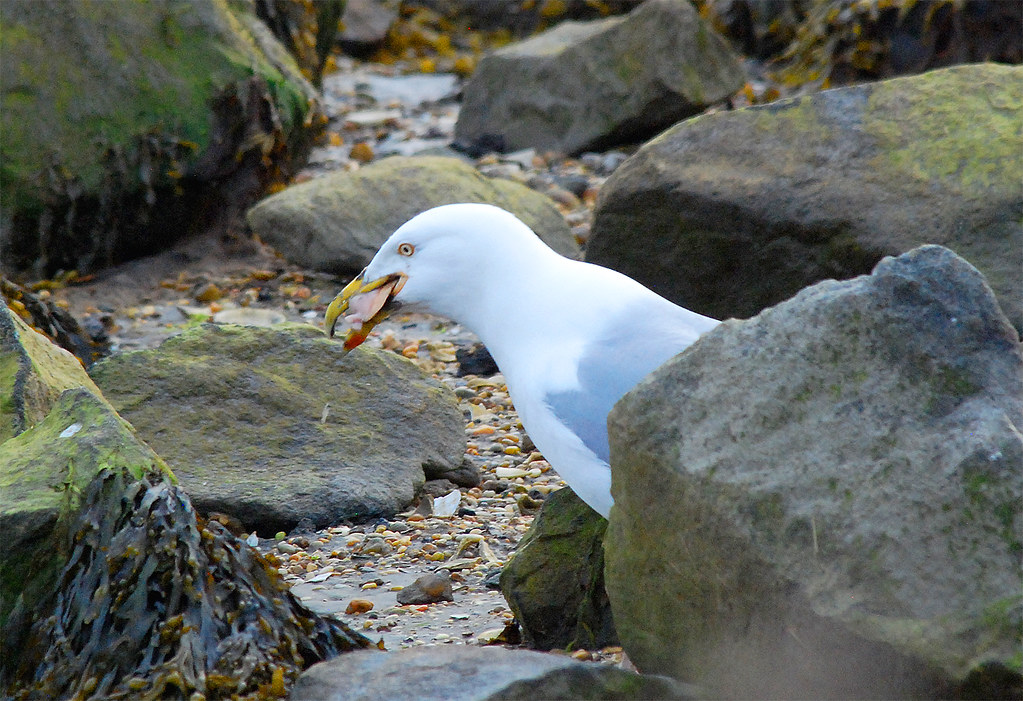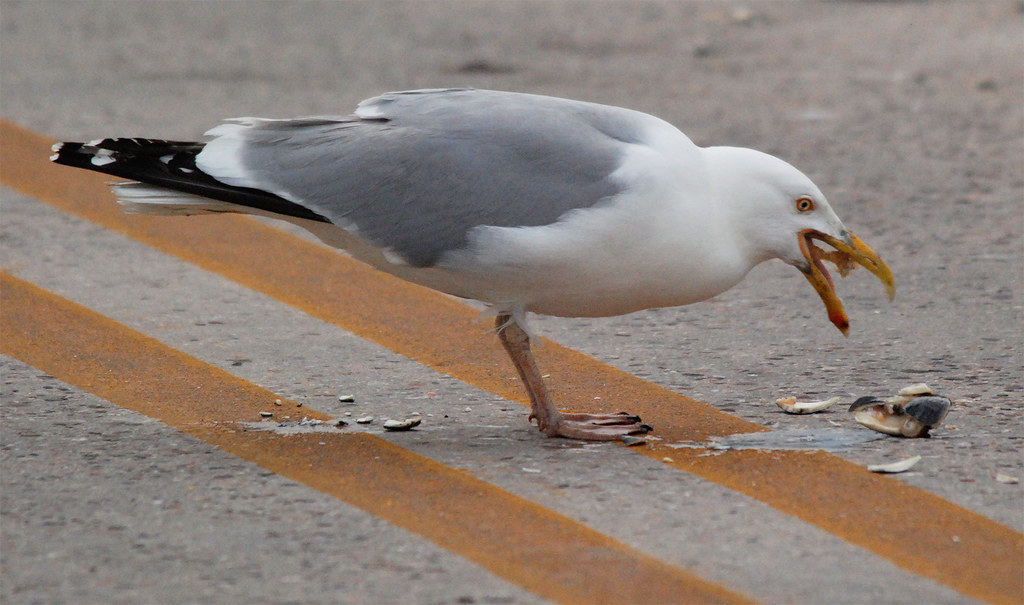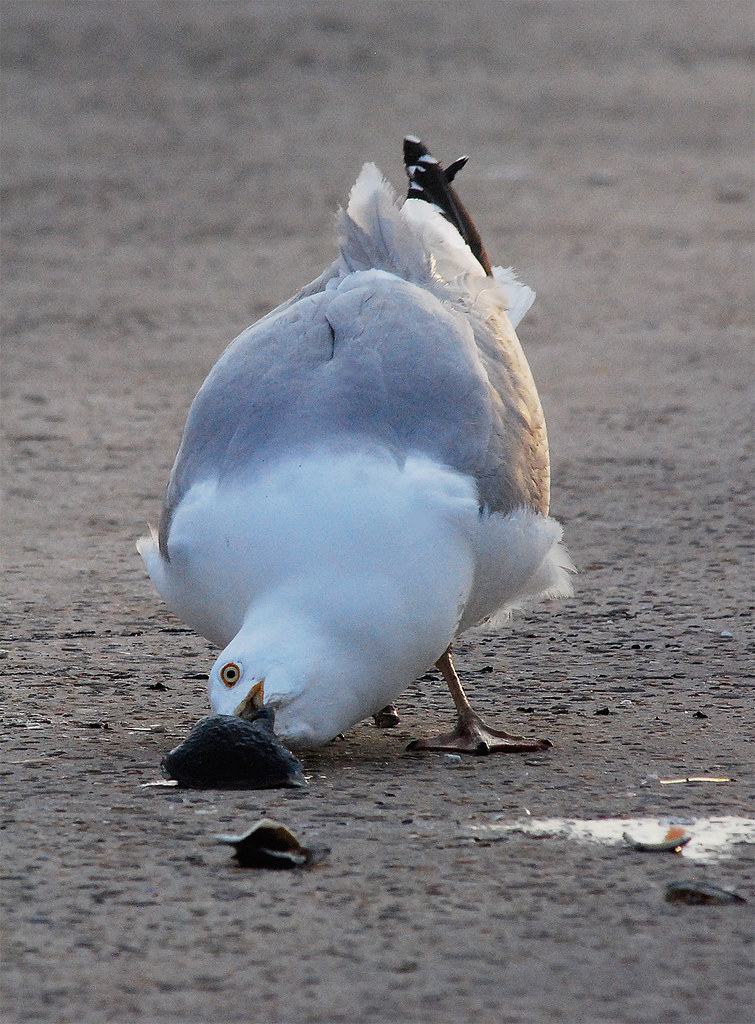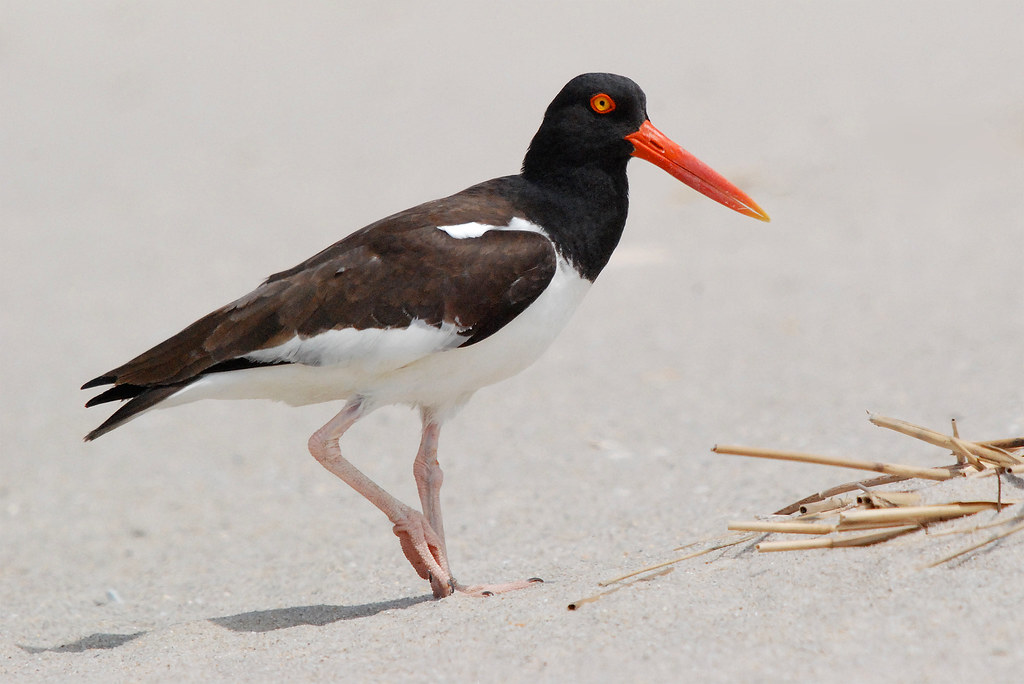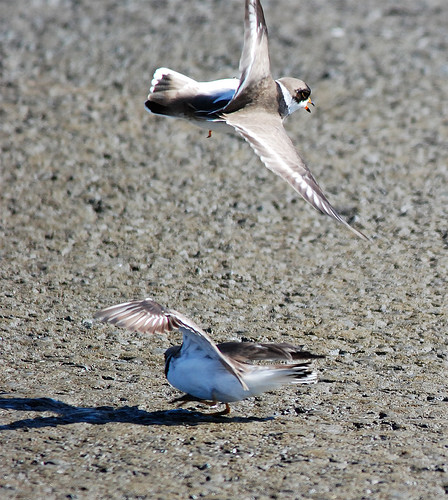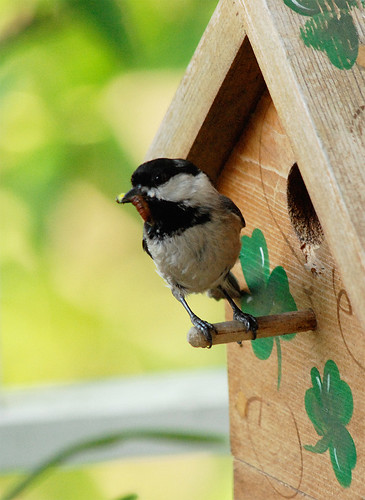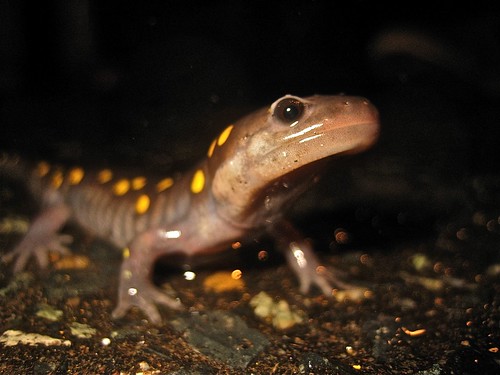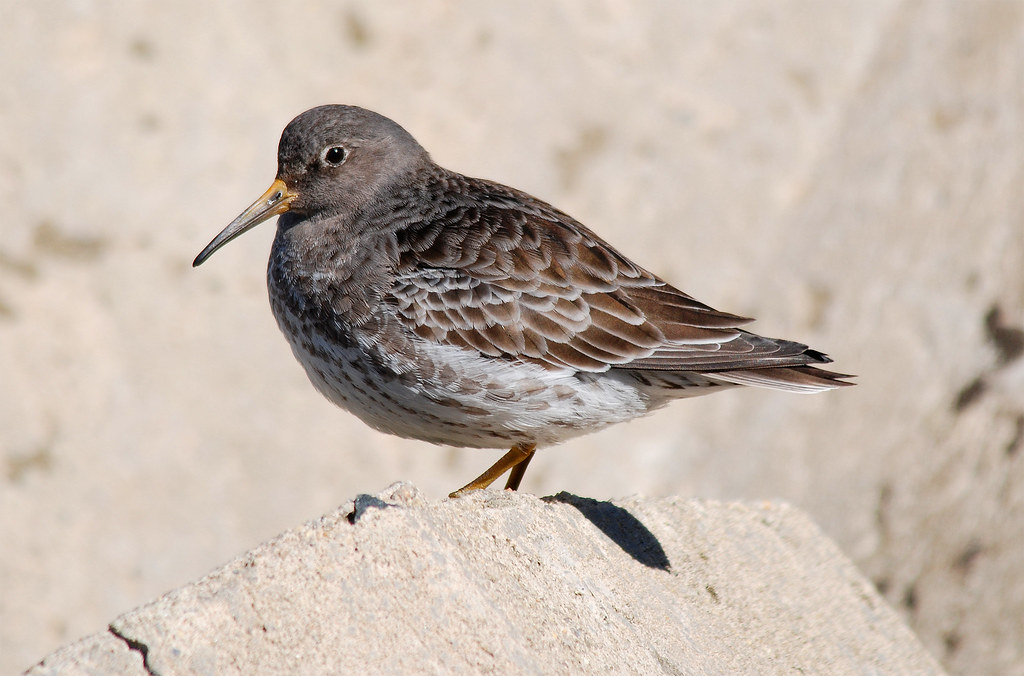We're in the process of making a switch to http://njoutdoors.wordpress.com/ - please continue to follow the blog at its new home! NJ Outdoors is expanding with more contributors in a number of different areas. We plan on having a constant flow of new material covering everything from birding and hiking to gardening and fishing! Like to surf? Send in a column! Have some cool photos from a recent camping trip? We'll post them!
Please send us an email at newjerseyoutdoors@gmail.com if you would like to be a regular contributor to the blog, or if you would like us to post your story, event, or pictures.
Thanks, everyone!
Friday, June 25, 2010
Wednesday, June 9, 2010
Tuesday, June 8, 2010
Jersey Fresh!
The 2010 growing season has already begun for most New Jersey farms, and there are plenty of opportunities to reap the delicious rewards! It's too late to purchase a CSA share (check out our food blog at Party of Two for updates on our Honeybrook Organic Farm CSA) - but there are plenty of other ways to join in on the Garden State's rich agricultural tradition.
Community and roadside farmers markets are an excellent way to find fresh and local produce in your area. Different markets offer different things - you will undoubtedly be able to find fruits and veggies in plentiful amounts, but some markets may also have stands selling cheeses, pickles, freshly baked breads and baked goods, and locally raised meats.
There are also some wonderful Pick-Your-Own opportunities throughout the state. Most PYO farms offer some combination of tree fruits (apples, peaches, etc) and berries (strawberries, blueberries, etc).
Check out the Department of Agriculture's Jersey Fresh website for listings of all the different stands and farms in your area, as well as a list of what types of produce are currently in season.
Community and roadside farmers markets are an excellent way to find fresh and local produce in your area. Different markets offer different things - you will undoubtedly be able to find fruits and veggies in plentiful amounts, but some markets may also have stands selling cheeses, pickles, freshly baked breads and baked goods, and locally raised meats.
There are also some wonderful Pick-Your-Own opportunities throughout the state. Most PYO farms offer some combination of tree fruits (apples, peaches, etc) and berries (strawberries, blueberries, etc).
Check out the Department of Agriculture's Jersey Fresh website for listings of all the different stands and farms in your area, as well as a list of what types of produce are currently in season.
Wednesday, June 2, 2010
Wednesday, May 19, 2010
Friday, May 14, 2010
World Series of Birding
New Jersey's World Series of Birding begins at midnight tonight! Teams from all over the state and country will compete to see who can identify (through sight and sound) the most species of birds within the state of NJ in a 24-hour period.
Our team will be competing for the 2nd year. Check out our recent blog post for updates and please consider supporting the team! Thanks, everyone.
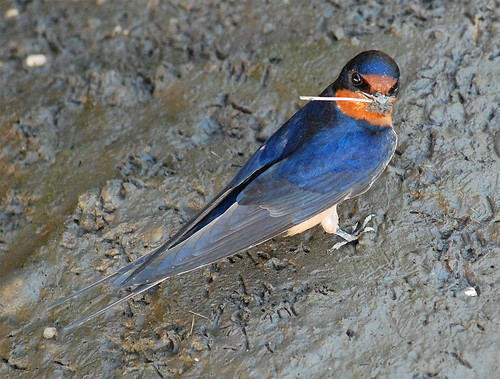
Our team will be competing for the 2nd year. Check out our recent blog post for updates and please consider supporting the team! Thanks, everyone.

Tuesday, May 11, 2010
Re-Purpose New Jersey!
 Rutgers University is hosting a Re-Purpose event where anyone can come and donate clothing, electronics, and other unwanted items. The following locations will be accepting donations from noon - 8pm on Wednesday, May 12th, and from 9am - noon on Thursday, May 13th:
Rutgers University is hosting a Re-Purpose event where anyone can come and donate clothing, electronics, and other unwanted items. The following locations will be accepting donations from noon - 8pm on Wednesday, May 12th, and from 9am - noon on Thursday, May 13th:• Busch: Richardson Lot 58B & Silvers Lot
• Livingston: Sidewalk between Quad 1 & 2 off Avenue E.
• CAC: Hardenburgh Hall Lot 20 & Stonier Lot 35
• Cook: Newells Lot 99a & Nicholas Lot 76
• Douglass: New Gibbons Lot 74A
Simply show up and donate! You can find more information (and volunteer) on the event's Facebook page or on the Re-Purpose New Jersey website.
Monday, April 19, 2010
Ag Field Day / Rutgers Day
If you ask the loyalists on the Cook and Douglass campuses what April 24th is called, they'll emphatically tell you it's "Ag Field Day". The annual event in New Brunswick has now been transformed into the broader, University-wide "Rutgers Day", but on the fields and farms of Cook/Douglass, they're hanging onto the 104-year old moniker.
Throughout the day there will be various tours, demonstrations, and lectures all over campus. On the big lawn on Cook/Douglass, the NJ Folk Festival will be held with live music, craft tents, artists, and food trucks. Read more about the food at Party of Two, our food blog.
The Ecology and Evolution Graduate Student Association will be leading tours throughout Helyar Woods and Rutgers Gardens during the day. It all kicks off at 8am as Brian Clough (member of our Scarlet Knight-Herons World Series of Birding team) leads a birding tour through Helyar Woods. Last year I co-led this tour with Charlie Kontos. We had a great turnout and ended up seeing a good number of bird species. Helyar Woods can be a great spot during migration, and there are sure to be a number of warblers and other songbirds flitting about. We had great looks at a Scarlet Tanager last year during the walk.
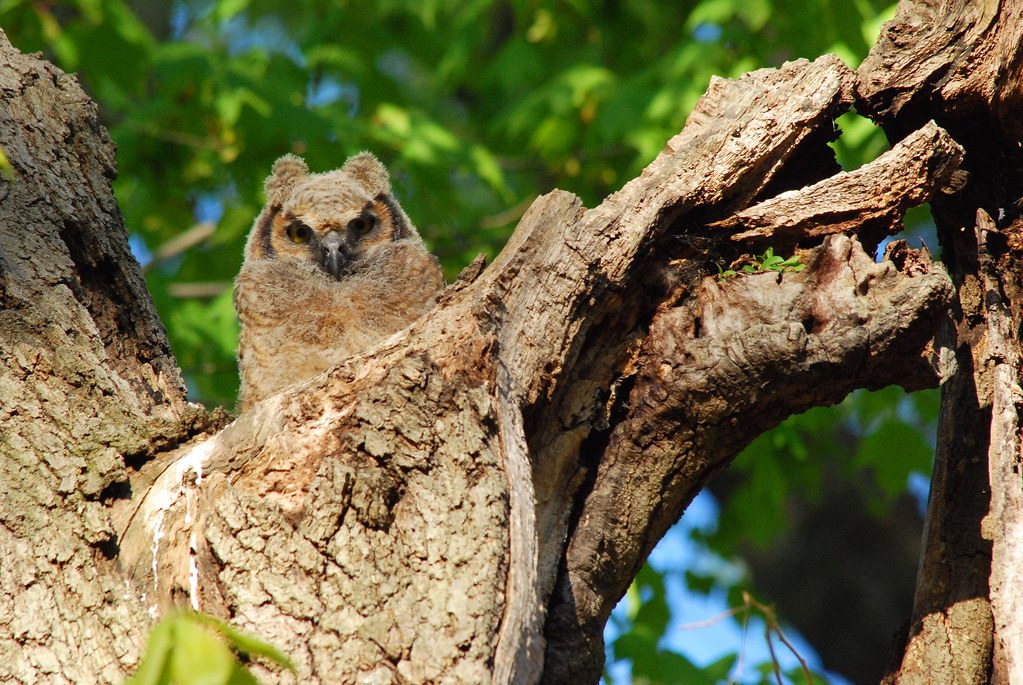
At 10am the husband-wife pairing of Kenneth Elgersma and Ai Wen will lead a "Scalies and Slimies" tour through the woods looking for any amphibians and reptiles they can turn up. We found a lone salamander last year during our bird walk, but they are sure to turn up more than that. The woods are home to a variety of snakes, turtles, frogs, and salamanders.
Sona Mason will lead a wildflower walk at 11am to round out the day at Rutgers Gardens/Helyar Woods. There are sure to be plenty of beautiful flowers to admire!
Faculty member Lena Struwe will lead a pair of tours through the Floriculture Greenhouse on Cook Campus. At 10:30 and 11:30 the walks will be "The Sex Life of Plants" and "Strange, Smelly, and Armed Plants", respectively. I've visited the Floriculture Greenhouse a number of times, and it is a REALLY neat place. There are a vast number of interesting and exotic plants to study and observe.
You can find more information about the April 24th events here:
http://agfieldday.rutgers.edu/
http://rutgersday.rutgers.edu/
http://www.ecogsa.rutgers.edu/agfieldday.html
Throughout the day there will be various tours, demonstrations, and lectures all over campus. On the big lawn on Cook/Douglass, the NJ Folk Festival will be held with live music, craft tents, artists, and food trucks. Read more about the food at Party of Two, our food blog.
The Ecology and Evolution Graduate Student Association will be leading tours throughout Helyar Woods and Rutgers Gardens during the day. It all kicks off at 8am as Brian Clough (member of our Scarlet Knight-Herons World Series of Birding team) leads a birding tour through Helyar Woods. Last year I co-led this tour with Charlie Kontos. We had a great turnout and ended up seeing a good number of bird species. Helyar Woods can be a great spot during migration, and there are sure to be a number of warblers and other songbirds flitting about. We had great looks at a Scarlet Tanager last year during the walk.

At 10am the husband-wife pairing of Kenneth Elgersma and Ai Wen will lead a "Scalies and Slimies" tour through the woods looking for any amphibians and reptiles they can turn up. We found a lone salamander last year during our bird walk, but they are sure to turn up more than that. The woods are home to a variety of snakes, turtles, frogs, and salamanders.
Sona Mason will lead a wildflower walk at 11am to round out the day at Rutgers Gardens/Helyar Woods. There are sure to be plenty of beautiful flowers to admire!
Faculty member Lena Struwe will lead a pair of tours through the Floriculture Greenhouse on Cook Campus. At 10:30 and 11:30 the walks will be "The Sex Life of Plants" and "Strange, Smelly, and Armed Plants", respectively. I've visited the Floriculture Greenhouse a number of times, and it is a REALLY neat place. There are a vast number of interesting and exotic plants to study and observe.
You can find more information about the April 24th events here:
http://agfieldday.rutgers.edu/
http://rutgersday.rutgers.edu/
http://www.ecogsa.rutgers.edu/agfieldday.html
Friday, April 9, 2010
Sandy Hook Birding
I joined fellow birders Tom Reed, Brian Clough, and Amy Manning for an early spring morning at Sandy Hook. We started at the north end of the Hook, where a new pond has been created thanks to all of the recent precipitation. Most conspicuous upon our arrival was a flock of Glossy Ibis feeding along the edge of the water. As we scanned the banks, we found the Stilt Sandpiper that had been reported, along with a Lesser Yellowlegs, a Willet, and a few Killdeer. A pair of Wood Ducks splashed down for a few moments before taking off again and flying out of sight.
Not a bad start to our morning! We started walking north toward the Fisherman's Trail when something hopped out of the grass and onto the concrete steps of one of the crumbling buildings. It hid behind a pillar for a moment before hopping up the steps and revealing itself to be none other than a Sora!
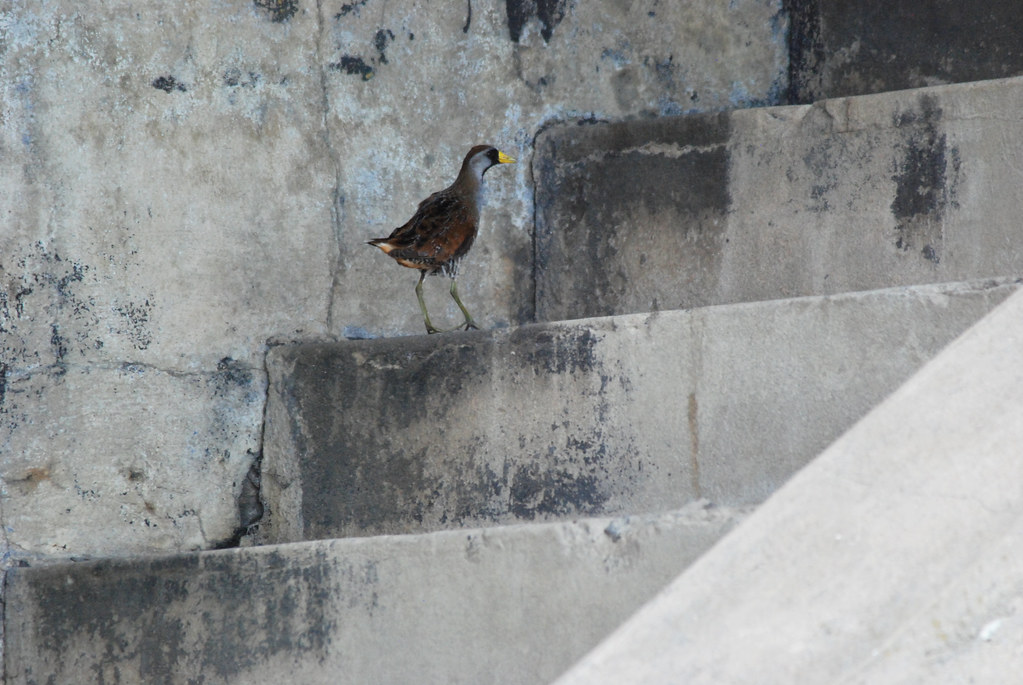
Soras are secretive marsh birds that are rarely seen, so witnessing this individual expose itself by climbing up steps was extremely unusual. Chances are it had been migrating over the area and was just plain exhausted. It continued up the steps, hopping one-by-one, until it had tucked itself away in a corner at the top (the steps led nowhere, by the way). We decided to move on quickly in the hopes that the Sora could continue on its journey undisturbed.
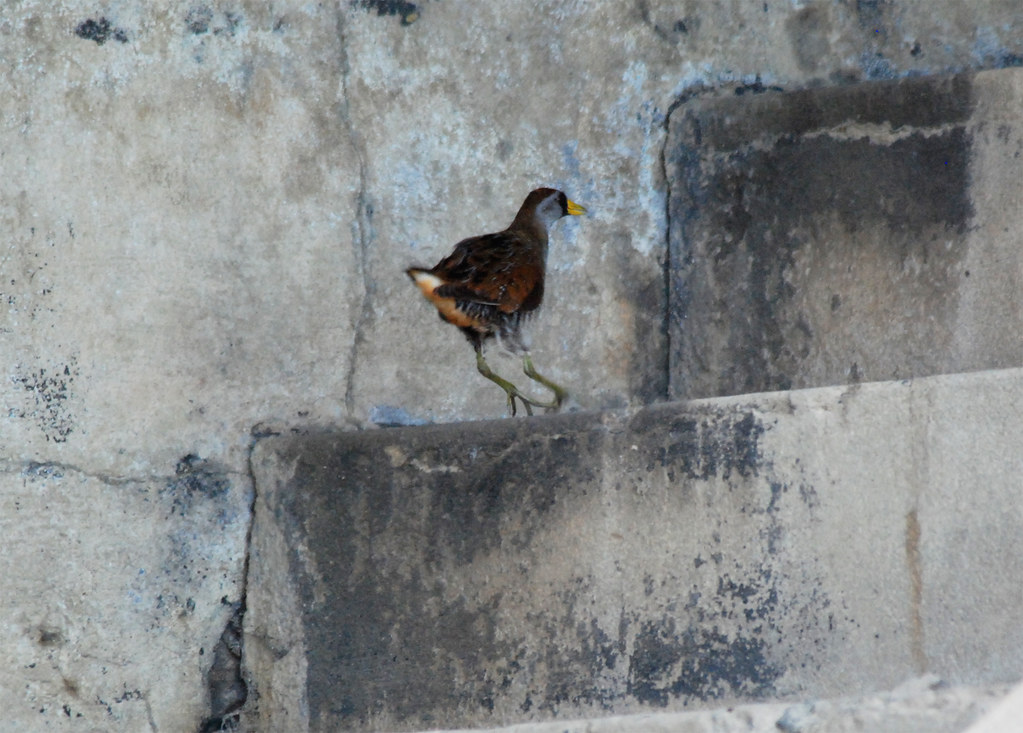
As we walked through the dunes of the Fisherman's Trail, we counted numerous Blue-Gray Gnatcatchers and Palm Warblers. A pair of Brown Thrashers flew low across the trail, and an adult White-Crowned Sparrow graced us with a quick glimpse of its impressive head coloration. The end of the trail led us out to an ocean view, which held a handful of Norther Gannets flying out over the water. A single Common Loon floated calmly in the water, with its beautiful breeding plumage starting to show. Across the water we could see a pair of American Oystercatchers moving up and down the beach. An Osprey flew over our heads with a nice meal.

After a quick trip down to the Boy Scout Camp area, we decided to head up to the Hawk Watch platform to see if the Swallow-tailed Kite would show up for a third day. Unfortunately we didn't find the kite, although we were treated to a pair of Common Ravens (quite the oddity for Sandy Hook), along with migrating Northern Harriers and Sharp-Shinned Hawks. An Eastern Bluebird even stopped on a nearby tree and posed for a few moments.
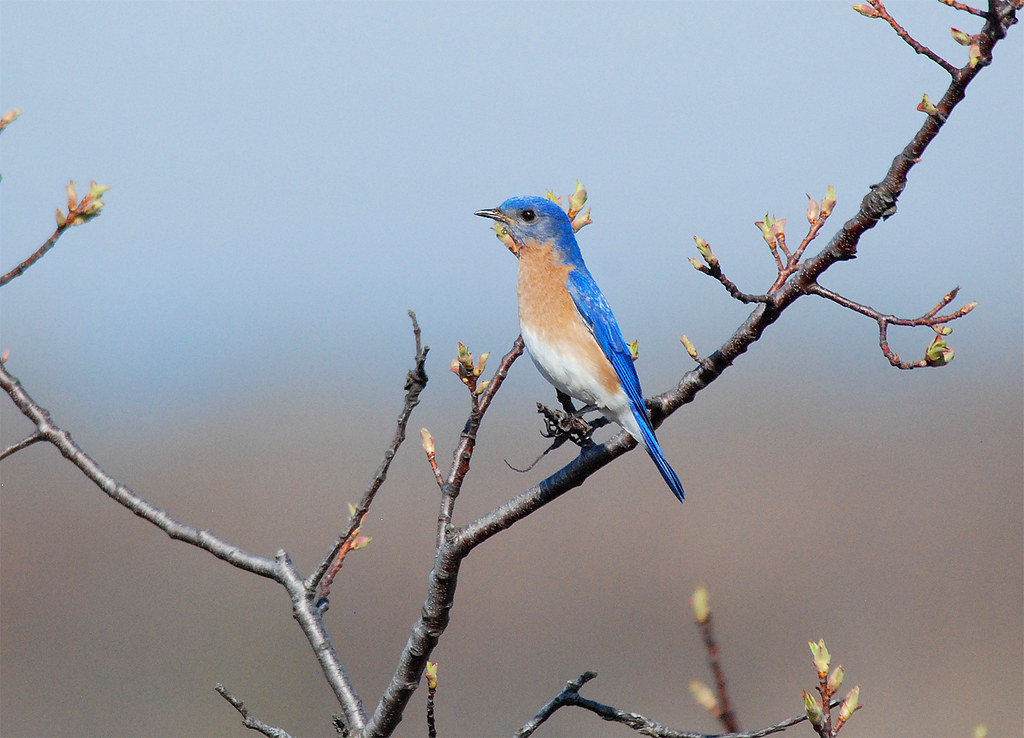
With the real world of work and school calling (not to mention a sweltering sun - I think NJ set a record high temperature), we decided to call it a day.
Migration has really kicked it into high gear, and with recent wind and temperature conditions, big-time rarities have already started showing up. Multiple Swallow-Tailed Kites and a Brown-Headed Nuthatch were spotted yesterday in Cape May. What will end up in New Jersey next week?
Not a bad start to our morning! We started walking north toward the Fisherman's Trail when something hopped out of the grass and onto the concrete steps of one of the crumbling buildings. It hid behind a pillar for a moment before hopping up the steps and revealing itself to be none other than a Sora!

Soras are secretive marsh birds that are rarely seen, so witnessing this individual expose itself by climbing up steps was extremely unusual. Chances are it had been migrating over the area and was just plain exhausted. It continued up the steps, hopping one-by-one, until it had tucked itself away in a corner at the top (the steps led nowhere, by the way). We decided to move on quickly in the hopes that the Sora could continue on its journey undisturbed.

As we walked through the dunes of the Fisherman's Trail, we counted numerous Blue-Gray Gnatcatchers and Palm Warblers. A pair of Brown Thrashers flew low across the trail, and an adult White-Crowned Sparrow graced us with a quick glimpse of its impressive head coloration. The end of the trail led us out to an ocean view, which held a handful of Norther Gannets flying out over the water. A single Common Loon floated calmly in the water, with its beautiful breeding plumage starting to show. Across the water we could see a pair of American Oystercatchers moving up and down the beach. An Osprey flew over our heads with a nice meal.

After a quick trip down to the Boy Scout Camp area, we decided to head up to the Hawk Watch platform to see if the Swallow-tailed Kite would show up for a third day. Unfortunately we didn't find the kite, although we were treated to a pair of Common Ravens (quite the oddity for Sandy Hook), along with migrating Northern Harriers and Sharp-Shinned Hawks. An Eastern Bluebird even stopped on a nearby tree and posed for a few moments.

With the real world of work and school calling (not to mention a sweltering sun - I think NJ set a record high temperature), we decided to call it a day.
Migration has really kicked it into high gear, and with recent wind and temperature conditions, big-time rarities have already started showing up. Multiple Swallow-Tailed Kites and a Brown-Headed Nuthatch were spotted yesterday in Cape May. What will end up in New Jersey next week?
Thursday, March 25, 2010
Wild parakeets in New Jersey
Believe or not, there are wild populations of Monk Parakeets living in the Garden State. These birds were released in New York in the middle of the last century, spread into the suburbs, and have somehow managed to survive the winters and continue to reproduce successfully for the last 50 or 60 years.

There are now a few colonies in New Jersey, with the largest containing about 50 of these native Argentinians. They use sticks and twigs to create large nests, such as the one pictured below. Usually built around transformers, it is believed they gain some measure of warmth from building their nests in these locations. Some officials have expressed concern over potential problems, but so far the birds haven't caused any harm.

As serious birders know, last year the Monk Parakeet was added to the official New Jersey state checklist, recognizing the species as a sustainable population in the state. Unlike escapees from homes and pet stores, this means the birds are known to be permanent residents here in NJ, able to breed and live in the wild. How these South American parakeets have survived the frigid winters here in the northeast is anyone's guess - but they have.

The small colony we visited in Carteret seemed to have at least five birds heading in and out of the nest. We were informed by a resident that there is another colony only a few blocks away. The species seem completely out of place - bright green and blue birds feeding in empty lots, chomping on grass (see the photo below) and hanging around with European Starlings and Mourning Doves.
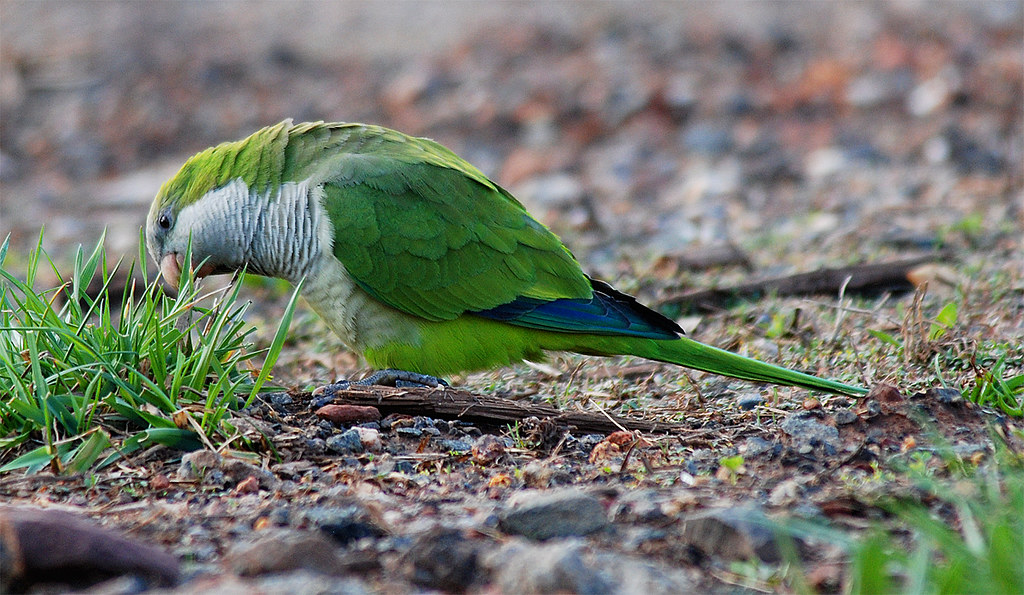
As long as the species remains confined to these types of areas and their population sizes stay relatively low, they don't seem to pose much of a threat. In Argentina they are considered agricultural pests, so there has been some concern over the possibility of populations spreading to more rural regions. I certainly hope that doesn't happen, as these birds were a real treat to watch. I wouldn't want to have to lump them in with other invasive avian species like the House Sparrow and European Starling - yuck!

There are now a few colonies in New Jersey, with the largest containing about 50 of these native Argentinians. They use sticks and twigs to create large nests, such as the one pictured below. Usually built around transformers, it is believed they gain some measure of warmth from building their nests in these locations. Some officials have expressed concern over potential problems, but so far the birds haven't caused any harm.

As serious birders know, last year the Monk Parakeet was added to the official New Jersey state checklist, recognizing the species as a sustainable population in the state. Unlike escapees from homes and pet stores, this means the birds are known to be permanent residents here in NJ, able to breed and live in the wild. How these South American parakeets have survived the frigid winters here in the northeast is anyone's guess - but they have.

The small colony we visited in Carteret seemed to have at least five birds heading in and out of the nest. We were informed by a resident that there is another colony only a few blocks away. The species seem completely out of place - bright green and blue birds feeding in empty lots, chomping on grass (see the photo below) and hanging around with European Starlings and Mourning Doves.

As long as the species remains confined to these types of areas and their population sizes stay relatively low, they don't seem to pose much of a threat. In Argentina they are considered agricultural pests, so there has been some concern over the possibility of populations spreading to more rural regions. I certainly hope that doesn't happen, as these birds were a real treat to watch. I wouldn't want to have to lump them in with other invasive avian species like the House Sparrow and European Starling - yuck!
Tuesday, March 16, 2010
Salamander migration
While many eyes and binoculars will be pointed toward the sky in anticipation of spring migration, another type of migration has already begun here in New Jersey. Late last week, as temperatures rose and rain started to fall, amphibians started to stir.
The migration of a salamander isn't exactly the 40,000 mile round-trip of the Arctic Tern, but it is just as important to these amphibian species. After awakening from their winter slumber, they have to move into vernal pools, seasonal ponds that fill with water during late winter and spring. Unfortunately many of these areas have been filled for development, and those that remain may be cut off from breeding populations by roads or other man-made obstacles. As salamanders move across roads in concentrated numbers, it only takes one car to drastically alter their population size, which could ultimately lead to local extinctions.
One of the best known spots for salamander migration in the area is East Brunswick's Beekman Road. The town closes the road when conditions are favorable to limit the hurdles these animals must overcome to reach the vernal pools. Nature-lovers flock to the area when the migration begins, and carefully scan the road for different species.
The migration event lasts for only a few short weeks, and will only occur on warm, wet evenings. Rainfall is being predicted for the latter part of this upcoming weekend and early next week, so that may very well be the next best time to check out these little critters.
Please check the Salamander Page of the East Brunswick Environmental Commission for updates on when the road will be closed for migration. Currently there is also an emergency alert due to the recent storm.
The migration of a salamander isn't exactly the 40,000 mile round-trip of the Arctic Tern, but it is just as important to these amphibian species. After awakening from their winter slumber, they have to move into vernal pools, seasonal ponds that fill with water during late winter and spring. Unfortunately many of these areas have been filled for development, and those that remain may be cut off from breeding populations by roads or other man-made obstacles. As salamanders move across roads in concentrated numbers, it only takes one car to drastically alter their population size, which could ultimately lead to local extinctions.
One of the best known spots for salamander migration in the area is East Brunswick's Beekman Road. The town closes the road when conditions are favorable to limit the hurdles these animals must overcome to reach the vernal pools. Nature-lovers flock to the area when the migration begins, and carefully scan the road for different species.
The migration event lasts for only a few short weeks, and will only occur on warm, wet evenings. Rainfall is being predicted for the latter part of this upcoming weekend and early next week, so that may very well be the next best time to check out these little critters.
Please check the Salamander Page of the East Brunswick Environmental Commission for updates on when the road will be closed for migration. Currently there is also an emergency alert due to the recent storm.
Tuesday, March 9, 2010
North Shore
American Woodcocks are being seen and heard throughout the state. Butterflies started to appear this week. And just yesterday, an Osprey was seen flying over Cape May. Despite these signs of spring, winter isn't over just yet! I headed down to the "North Shore" of NJ with some fellow birders (and graduate students in the Ecology & Evolution program at Rutgers University) to see what winter waterfowl were still hanging around.

It turns out, quite a bit! We started in Belmar and walked the jetties at Shark River Inlet. There were good numbers of Long-Tailed Ducks and Common Loons in the water, and eventually we spotted a Western Grebe that had been observed a few times earlier in the year.
We moved south down the coast, stopping to scan the ocean whenever we were offered a good vantage point. A few Red-Throated Loons were added to the mix, although we had no luck finding the Pacific Loon that had been reported earlier in the week. Black Scoters and Surf Scoters were also seen out in the Atlantic, along with a rare winter sighting of a sub-species of Homo sapiens: the surfer!

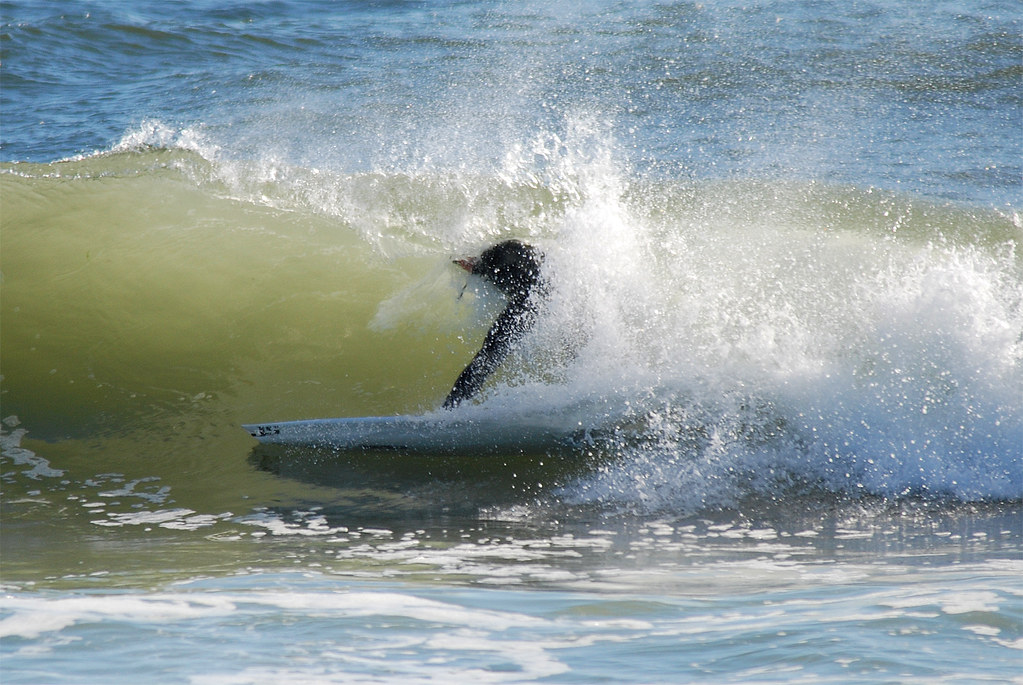
As we continued on our way, we visited some of the coastal lakes known for their wintering waterfowl. Almost annually you can find a Eurasian Wigeon in one of these lakes, and sometimes a Common "Eurasian" Teal as well. These are closely related to the American Wigeon and Green-Winged Teal that are found regularly in the United States, except the former species are lost individuals who have ended up on the wrong side of the pond. We weren't lucky enough to find either on this day, but we were able to observe large numbers of Red-Breasted Mergansers, Hooded Mergansers, Bufflehead, and Ruddy Ducks. We also found a pair of Green-Winged Teal, a single Lesser Scaup, and an American Wigeon.
Our next stop on the coast was the Manasquan Inlet. We walked the jetties again and were treated to more good looks at the aforementioned species. A few small groups of Purple Sandpipers moved around the jetties.
After dining on some authentic and completely delicious Mexican food at Jose's, we turned around and headed north. Our final stop was Sandy Hook. We searched the bay across from the Sandy Hook Bird Observatory, but weren't able to locate either species of goldeneye. However we did spot a seal sticking his nose out of the water, and were able to watch as a few male Red-Breasted Mergansers started practicing their mating display. If you haven't seen it, the display is quite entertaining.
We walked the beach one last time and saw our third species of scoter for the day - the White-winged Scoter. A nearby raft of Black Scoter afforded us some fantastic, crystal-clear views, and a single Surf Scoter ventured close to shore as well.
Soon all these birds will be heading north for the mating season, and a whole new group of birds will begin migrating through and settling in New Jersey. For most naturalists this time of year is truly exciting - birds in bright breeding plumage singing for prospective mates, salamanders migrating to precious vernal pools, and flowers blossoming in vibrant spring colors. The season is upon us!

It turns out, quite a bit! We started in Belmar and walked the jetties at Shark River Inlet. There were good numbers of Long-Tailed Ducks and Common Loons in the water, and eventually we spotted a Western Grebe that had been observed a few times earlier in the year.
We moved south down the coast, stopping to scan the ocean whenever we were offered a good vantage point. A few Red-Throated Loons were added to the mix, although we had no luck finding the Pacific Loon that had been reported earlier in the week. Black Scoters and Surf Scoters were also seen out in the Atlantic, along with a rare winter sighting of a sub-species of Homo sapiens: the surfer!


As we continued on our way, we visited some of the coastal lakes known for their wintering waterfowl. Almost annually you can find a Eurasian Wigeon in one of these lakes, and sometimes a Common "Eurasian" Teal as well. These are closely related to the American Wigeon and Green-Winged Teal that are found regularly in the United States, except the former species are lost individuals who have ended up on the wrong side of the pond. We weren't lucky enough to find either on this day, but we were able to observe large numbers of Red-Breasted Mergansers, Hooded Mergansers, Bufflehead, and Ruddy Ducks. We also found a pair of Green-Winged Teal, a single Lesser Scaup, and an American Wigeon.
Our next stop on the coast was the Manasquan Inlet. We walked the jetties again and were treated to more good looks at the aforementioned species. A few small groups of Purple Sandpipers moved around the jetties.
After dining on some authentic and completely delicious Mexican food at Jose's, we turned around and headed north. Our final stop was Sandy Hook. We searched the bay across from the Sandy Hook Bird Observatory, but weren't able to locate either species of goldeneye. However we did spot a seal sticking his nose out of the water, and were able to watch as a few male Red-Breasted Mergansers started practicing their mating display. If you haven't seen it, the display is quite entertaining.
We walked the beach one last time and saw our third species of scoter for the day - the White-winged Scoter. A nearby raft of Black Scoter afforded us some fantastic, crystal-clear views, and a single Surf Scoter ventured close to shore as well.
Soon all these birds will be heading north for the mating season, and a whole new group of birds will begin migrating through and settling in New Jersey. For most naturalists this time of year is truly exciting - birds in bright breeding plumage singing for prospective mates, salamanders migrating to precious vernal pools, and flowers blossoming in vibrant spring colors. The season is upon us!
Monday, March 1, 2010
Eco-travel & conservation in Peru
Eco-travel. Eco-tours. Eco-lodges. They all sound fun and adventurous - but what are they really doing for the natural world? In the case of Kolibri Expedition's 8-day birding trip through Manu National Park, plenty!
 Scarlet Macaws (c) Kaitlyn Rose
Scarlet Macaws (c) Kaitlyn Rose
 Black-Faced Brush-Finch (c) Carol Foil
Black-Faced Brush-Finch (c) Carol Foil
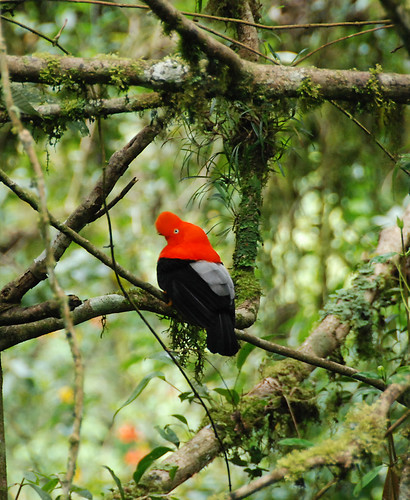 Andean Cock-of-the-Rock (c) Carol Foil
Andean Cock-of-the-Rock (c) Carol Foil
 Scarlet Macaws (c) Kaitlyn Rose
Scarlet Macaws (c) Kaitlyn RoseManu is a biosphere reserve located in Peru, offering some of the most awe-inspiring glimpses into the wild that you can find anywhere on the planet. Within the park you can find over 15,000 species of plants, 1,300 butterfly species, and...wait for it...1,000 species of birds! That's more than you can find throughout all of Canada and the United States.
 Black-Faced Brush-Finch (c) Carol Foil
Black-Faced Brush-Finch (c) Carol FoilThe 8-day adventure through Manu's various hot spots isn't all fun and games, though. For the traveler it may be all about birds, or bugs, or flowers - but for the people of Peru it is about protecting and preserving this exceptional example of life on Earth. Instead of mining, logging, and exploiting other natural resources, the people of the Amarakaeri communal reserve outside of Manu are working toward more sustainable forms of industry. Eco-tourism is at the forefront of this crisis, and Kolibri Expeditions is lending a much-needed hand to the communities of the Amarakaeri.
 Andean Cock-of-the-Rock (c) Carol Foil
Andean Cock-of-the-Rock (c) Carol FoilI will be serving as the hosting blogger for the May 23rd trip, which you can sign up for here. I strongly encourage anyone interested in eco-tourism and/or birding to think about making Manu your 2010 vacation. Not only will you be able to visit some of the most spectacular places in the world, see some of the most breath-taking birds, and meet some of the nicest people - but you will be helping those birds and helping those people keep the natural areas of South America wild and free from bulldozers and dynamite. The price of the trip drops precipitously as more people sign up, so I encourage people to email kolibriexp@gmail.com with your name - or you can reserve your space right on the event page at the bottom.
Thursday, February 25, 2010
More snow?!
Yup, that's right. As of this posting, more snow is falling throughout the Garden State. The Revenge of Snowmageddon, Snowpocalypse: Redux, or whatever you might call it - the snow is back for another round. That will probably mean driving through some slush, shoveling out some driveways and sidewalks, and brushing off cars. It can also mean tons of fun, though!
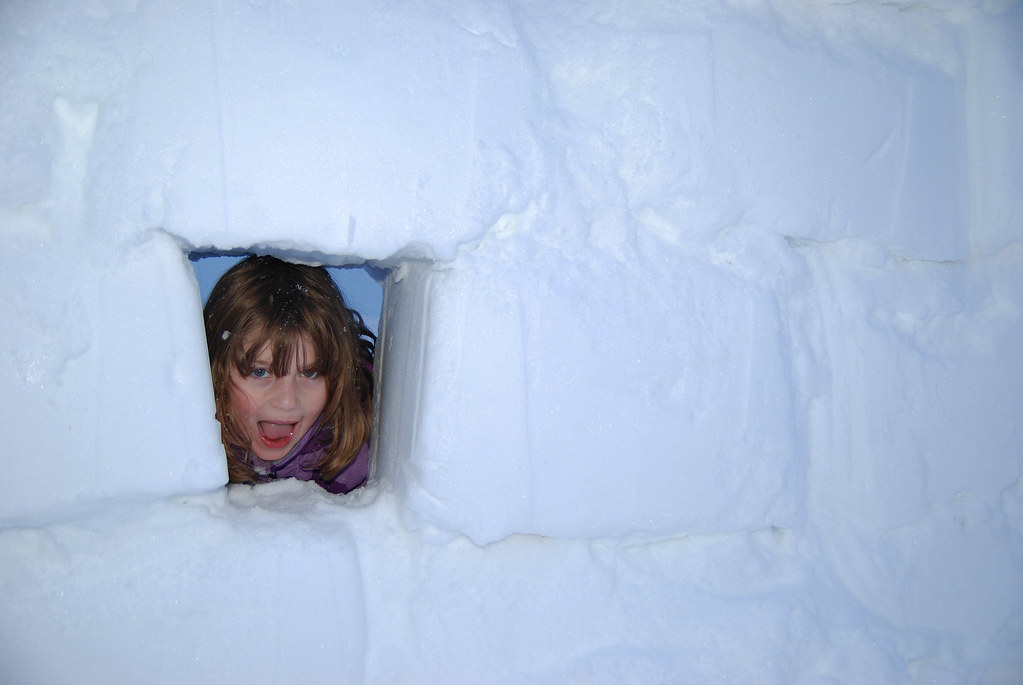
This is my little sister, Alyssa, peering through the window of the snow fort we made after the last big snow storm. We used paper recycling bins to pack snow into bricks and built up the walls to about four feet high. And of course some intimidating icicles were needed to help deter enemy attacks.
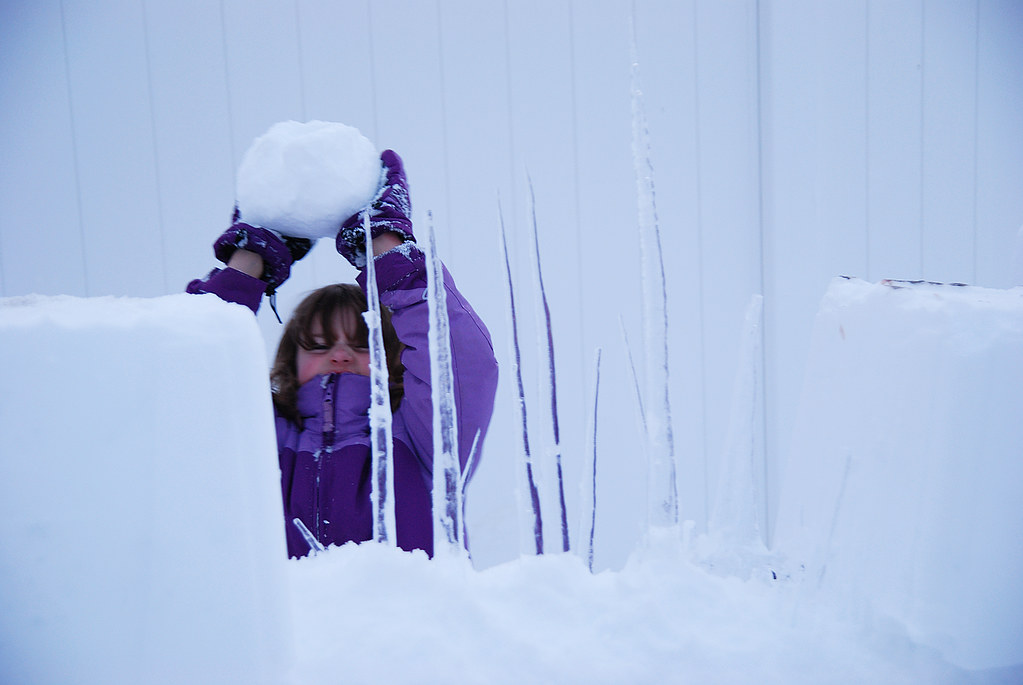


After working construction for two or three hours it was nice to sit back and relax with a cup of hot chocolate inside our newly built snow fortress. My wife, Elizabeth, was thanked with a snowball to the back of the head! Six-year olds. Sheesh.

I went back over the next morning to play with Alyssa before work, and ended up burying her in the snow. Some husbandly revenge, perhaps.

A few days later my Dad brought over my other two little sisters (ah, the joys of a modern family) to play for a bit in the snow. We ended up entrenched in a classic snowball fight. Sarah took great pleasure in dodging Dad's attack:
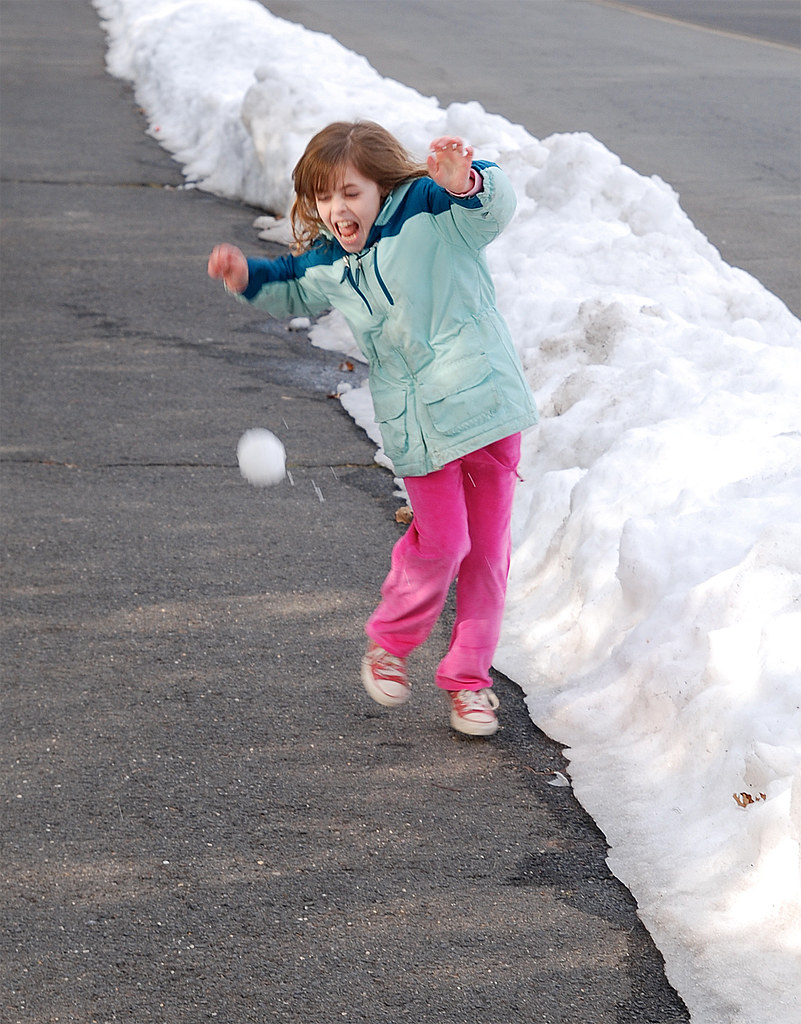
The snow and ice also grant some great opportunities for photography.

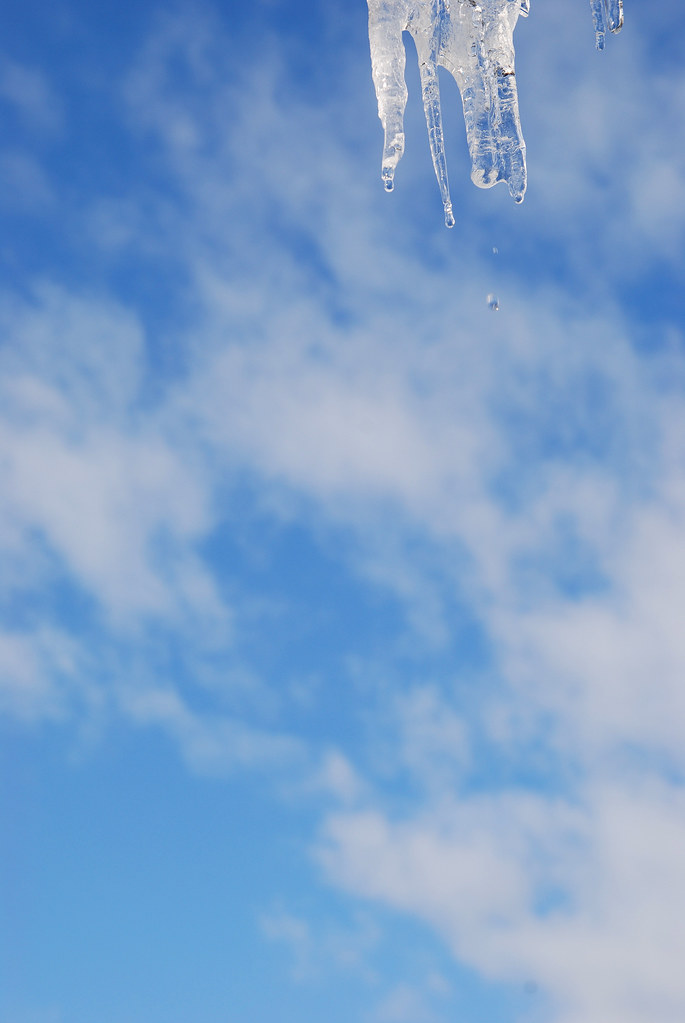
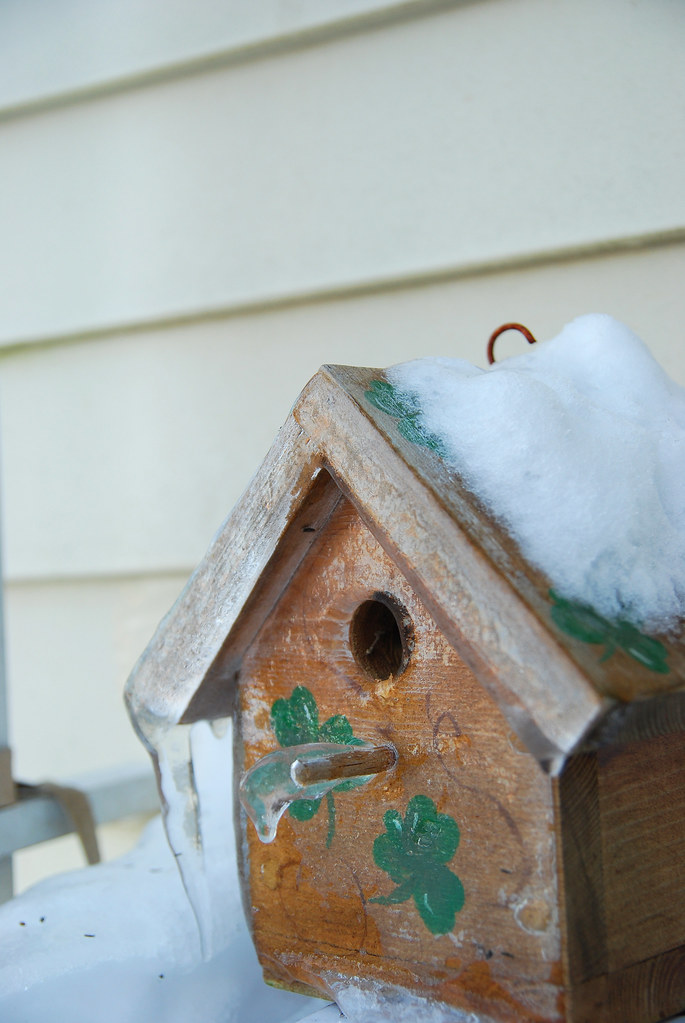
Bundling up and drinking hot chocolate while watching a movie is nice, but don't ignore the great possibilities of a fun snow day! Go sledding, take a hike, build a fort! And of course if you're a bird-watcher don't forget to stock those feeders!


This is my little sister, Alyssa, peering through the window of the snow fort we made after the last big snow storm. We used paper recycling bins to pack snow into bricks and built up the walls to about four feet high. And of course some intimidating icicles were needed to help deter enemy attacks.



After working construction for two or three hours it was nice to sit back and relax with a cup of hot chocolate inside our newly built snow fortress. My wife, Elizabeth, was thanked with a snowball to the back of the head! Six-year olds. Sheesh.

I went back over the next morning to play with Alyssa before work, and ended up burying her in the snow. Some husbandly revenge, perhaps.

A few days later my Dad brought over my other two little sisters (ah, the joys of a modern family) to play for a bit in the snow. We ended up entrenched in a classic snowball fight. Sarah took great pleasure in dodging Dad's attack:

The snow and ice also grant some great opportunities for photography.



Bundling up and drinking hot chocolate while watching a movie is nice, but don't ignore the great possibilities of a fun snow day! Go sledding, take a hike, build a fort! And of course if you're a bird-watcher don't forget to stock those feeders!

Thursday, February 11, 2010
Obligatory Snow Day Post!
On an average day we might have two or three Dark-Eyed Juncos on our feeders, along with a Black-Capped Chickadee and maybe a few other individuals. We're on the third floor and have a modest setup (two suet cages and a sock feeder) in the branches next to our balcony.
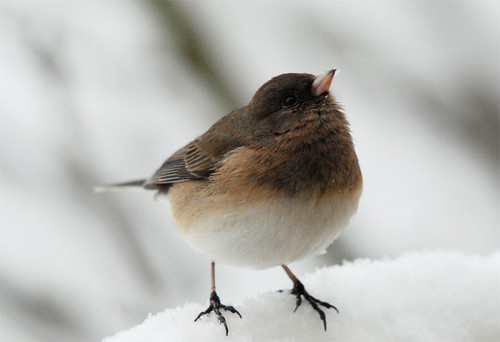
On the evening before the big storm of February 10th, I had actually used up the last of our seed and dumped the remnants of the bag on the thin layer of snow that was leftover from last week's storm. Whoops - there was actually more left than I had thought. Oh well, the birds will find it...holy moly, did the birds find it! We woke up to a literal carpet of juncos on our balcony, furiously kicking up snow to locate as many seeds as they could. At any given time throughout the day I counted between 10 and 13 juncos.
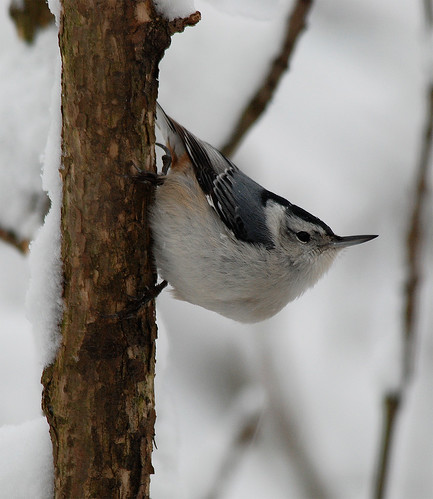 In addition to what have become daily visits from the Red-Breasted Nuthatches, the White-Breasted Nuthatches returned today and posed for a little bit before heading to the suet feeder.
In addition to what have become daily visits from the Red-Breasted Nuthatches, the White-Breasted Nuthatches returned today and posed for a little bit before heading to the suet feeder.
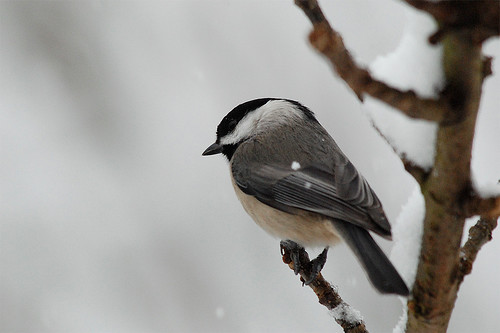 Of course a pair of Black-Capped Chickadees showed up and patiently waited their turn as the more aggressive Tufted Titmice and House Sparrows hogged the suet feeders. Once in awhile one would hop up to the pine cone feeder (made by my 5-year old sister Emma) and take a few nibbles.
Of course a pair of Black-Capped Chickadees showed up and patiently waited their turn as the more aggressive Tufted Titmice and House Sparrows hogged the suet feeders. Once in awhile one would hop up to the pine cone feeder (made by my 5-year old sister Emma) and take a few nibbles.
 I sprinkled some more seed out on the balcony and eventually this male House Finch joined in on the buffet. I've seen them around before (usually on our sock feeder during the spring), but it had been awhile and it was nice to see that splash of red. Another bird joined the feeding frenzy - a new visitor to our home!
I sprinkled some more seed out on the balcony and eventually this male House Finch joined in on the buffet. I've seen them around before (usually on our sock feeder during the spring), but it had been awhile and it was nice to see that splash of red. Another bird joined the feeding frenzy - a new visitor to our home!
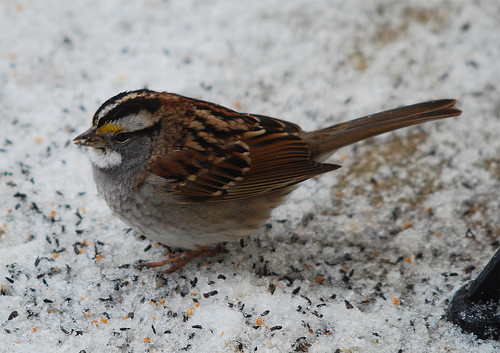 A White-Throated Sparrow jostled for dominance with a few of the male juncos, but there was plenty for everyone. Soon enough we had another new bird for our "yard" list! A Red-Bellied Woodpecker flew in and started slowly making his way up one of the branches.
A White-Throated Sparrow jostled for dominance with a few of the male juncos, but there was plenty for everyone. Soon enough we had another new bird for our "yard" list! A Red-Bellied Woodpecker flew in and started slowly making his way up one of the branches.
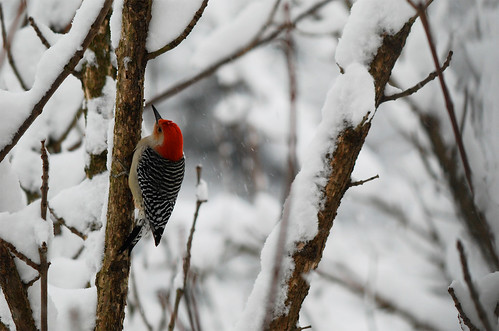
There's just something about the red on some birds that looks great against the white and gray of a snowy day.
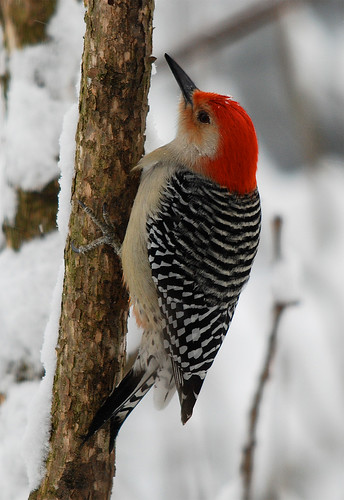

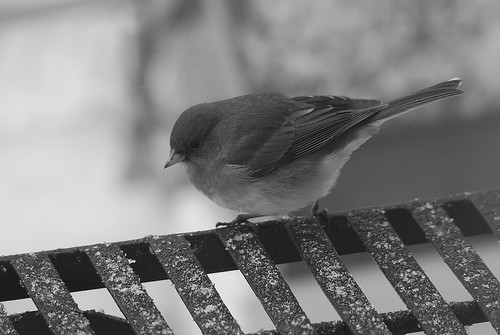

Unfortunately the third new bird we added during the snow was the European Starling. I guess the rest of the birds had finally tipped them off. Thankfully only three or four actually ended up in the tree, and they only fed on the suet for a short time before moving on. Kind of strange, actually. Perhaps they sensed my displeasure with their presence.

There is nothing more appealing than the sight of a bright male Northern Cardinal in the snow - again, back to that red thing. Unfortunately he never really came out into the open, so this photo was all I could muster:

Now is the time when a bird's resources are the most scarce! Seeds, nuts, and any lingering insects have totally vanished after a snow storm like the one the east coast just suffered - birds can't find 'em and so they need the help of our feeders more than ever. If you've been putting it off - don't any longer! Get out there and fill 'em up with plenty of seed and suet. The birds will thank you. :)

On the evening before the big storm of February 10th, I had actually used up the last of our seed and dumped the remnants of the bag on the thin layer of snow that was leftover from last week's storm. Whoops - there was actually more left than I had thought. Oh well, the birds will find it...holy moly, did the birds find it! We woke up to a literal carpet of juncos on our balcony, furiously kicking up snow to locate as many seeds as they could. At any given time throughout the day I counted between 10 and 13 juncos.
 In addition to what have become daily visits from the Red-Breasted Nuthatches, the White-Breasted Nuthatches returned today and posed for a little bit before heading to the suet feeder.
In addition to what have become daily visits from the Red-Breasted Nuthatches, the White-Breasted Nuthatches returned today and posed for a little bit before heading to the suet feeder. Of course a pair of Black-Capped Chickadees showed up and patiently waited their turn as the more aggressive Tufted Titmice and House Sparrows hogged the suet feeders. Once in awhile one would hop up to the pine cone feeder (made by my 5-year old sister Emma) and take a few nibbles.
Of course a pair of Black-Capped Chickadees showed up and patiently waited their turn as the more aggressive Tufted Titmice and House Sparrows hogged the suet feeders. Once in awhile one would hop up to the pine cone feeder (made by my 5-year old sister Emma) and take a few nibbles. I sprinkled some more seed out on the balcony and eventually this male House Finch joined in on the buffet. I've seen them around before (usually on our sock feeder during the spring), but it had been awhile and it was nice to see that splash of red. Another bird joined the feeding frenzy - a new visitor to our home!
I sprinkled some more seed out on the balcony and eventually this male House Finch joined in on the buffet. I've seen them around before (usually on our sock feeder during the spring), but it had been awhile and it was nice to see that splash of red. Another bird joined the feeding frenzy - a new visitor to our home!  A White-Throated Sparrow jostled for dominance with a few of the male juncos, but there was plenty for everyone. Soon enough we had another new bird for our "yard" list! A Red-Bellied Woodpecker flew in and started slowly making his way up one of the branches.
A White-Throated Sparrow jostled for dominance with a few of the male juncos, but there was plenty for everyone. Soon enough we had another new bird for our "yard" list! A Red-Bellied Woodpecker flew in and started slowly making his way up one of the branches.
There's just something about the red on some birds that looks great against the white and gray of a snowy day.




Unfortunately the third new bird we added during the snow was the European Starling. I guess the rest of the birds had finally tipped them off. Thankfully only three or four actually ended up in the tree, and they only fed on the suet for a short time before moving on. Kind of strange, actually. Perhaps they sensed my displeasure with their presence.

There is nothing more appealing than the sight of a bright male Northern Cardinal in the snow - again, back to that red thing. Unfortunately he never really came out into the open, so this photo was all I could muster:

Now is the time when a bird's resources are the most scarce! Seeds, nuts, and any lingering insects have totally vanished after a snow storm like the one the east coast just suffered - birds can't find 'em and so they need the help of our feeders more than ever. If you've been putting it off - don't any longer! Get out there and fill 'em up with plenty of seed and suet. The birds will thank you. :)
Subscribe to:
Comments (Atom)
